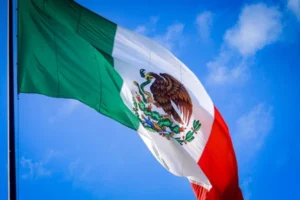Origins
The area of Coyoacán dates back to pre-Hispanic times where it was fragmented from the central part thanks to the waters that crossed the ancient city. Its name in Nahuatl means “place of coyotes” or “place of coyote owners” and responds to a petroglyph called Coyohuacan with the image of this animal, current symbol of the local government. Established the Viceroyalty, it became the capital of New Spain incorporating surrounding areas. At present it constitutes the area of expansion of the city. Its placid, quiet appearance makes it a refuge from the hectic life of the capital where visitors are invited to walk its streets, cafes and restaurants to enjoy the local cuisine.
Centennial Garden and Hidalgo Garden, Coyoacanense essence
In Coyoacán there are two sites of greatest interest. They are the most important squares that head the outdoor places to visit and that are defining the essence of Coyoacan: Los Jardines del Centenario and Plaza El Hidalgo. Located in the historic center of Coyoacán, they are places frequented by artists, intellectuals and writers.
The Centennial Gardens is the recreational epicenter of this part of the city and that well portrays, next to the houses that surround it, the Colonial Coyoacan. Around it stand out the main streets of the town. It has in the center the emblematic fountain composed of two coyotes, symbol of the original autochthonous. The most important value it brings is that each visitor appropriates their spaces in total safety. Its benches invite you to sit down to contemplate its surroundings. The gardens, their wooded spaces, fountains and squares provide a moment of solaz with sales of handicrafts and where an air of quiet celebration reigns.
In the streets that surround it we find multiple cultural centers and museums: The House of Culture Reyes Heroles, the Museum of Popular Cultures, the Museum of Watercolor, the CoyoacanEnse Forum, the Museum of Interventions and others becoming a true cultural artistic epicenter of the town, both day and night. Tapas and snacks are offered during the day. The night is adorned with bars whose offer lies in the best of typical drinks. The surrounding streets offer you a beautiful view of colonial mansions. The best of Coyoacán is offered by Los Jardines del Centenario and without paying a peso for it.
The Plaza or Jardín Hidalgo is also located in the historic center of Coyoacán. It is the second most visited square in Mexico after the Zócalo. It is a space close to the Centennial Gardens but with more activity in its corridors. You can walk among its gardens with a view of its buildings from the time of the conquest such as the house of Hernán Cortés, current Municipal House, the parish of San Juan Bautista with its convent, as well as the monument to Don Miguel Hidalgo y Costilla and the Kiosk of Coyoacán, the latter from the early twentieth century.
This square has a great vitality and color contributed by street vendors, globeros, dancers and boleros. As well as typical celebrations such as the Day of the Dead, the Tamal Fair and Independence Day, as well as concerts among others. If you want to facilitate the tour of the square you can get on the Coyoacán Tram. Their guides will tell you stories of how the city was founded while you do the walk.
Blue House of Frida Khalo
In Coyoacán resides one of the most popular museums in all of Mexico. The Blue House was the place of residence, as well as a workshop, of one of the most important Mexican painters: Frida Khalo. In it he lived with the family in childhood and then shared it with his no less famous partner, the painter Diego Rivera. In his spaces we can visualize some of his works and belongings that he shared in life with the painter.
The house with its structure, kitchen, dining room, rooms, gardens and study, reveals the essence of the Frida Khalo woman, her intimacy, her eccentricities and everything that defined her creative character. Temporary collections are also exhibited where clothes and personal objects of the artist are exhibited. In 1958 Diego Rivera decided to turn the house into a museum at Frida’s request after her death. Artistic objects such as pre-Columbian sculptures, works of popular art, photographs and documents are also exhibited. To get a broader view of Frida Khalo, a painter, you can visit the Dolores Olmedo Museum in Xochimilco.
The church of La Conchita
The chapel of the Immaculate Conception or as it is better known as La Iglesia de la Conchita, offers you a moment of solace in an afternoon of walking. When Hernán Cortez arrived in Coyoacán, he had the church built. Later through excavations it is verified that it was a Toltec ceremonial center. The church is of baroque style of the S. XVII. The square has a panoramic view of colonial buildings.
As far as the surroundings of the La Conchita Church are concerned, it offers you possibilities for relaxation by having a delicious coffee or an ice cream in the places that are traditional, in addition to shopping in the different bazaars. There are also cultural centers such as the Higher School of Music of the National Institute of Fine Arts with an interesting weekly program of concerts. The Cultural Center “Elena Garro” with its theater presentations, ensembles and books.
The Coyoacanense Cultural Forum “Hugo Arguelles”
In its beginnings it was inaugurated as a Gallery for exhibitions of Plastic Arts. Later it changes its objective as a space for dissemination and promotion for culture and art. It has become one of the main stages for the presentation of theatrical works with a stall for 270 people. It also houses the Coyoacán Symphony Orchestra permanently at its headquarters for periodic performances. Its cultural agenda also encompasses dance, music and film.
National Museum of Popular Cultures
Listed as a historical museum, the building belonged to the parish of San Juan Bautista until 1734. Passing through various hands, it is not until 1982 that it was decreed by President López Portillo as the National Museum of Popular Cultures. This museum in Coyoacán became a reference space, both nationally and internationally, that exhibits the autochthonous expressions of the Mexican native peoples. Their cosmogony and the different social, artistic and cultural expressions that define them as a people find their foothold in every corner of it. It is particularly memorable to visit it at the end of October, the beginning of November, when indigenous people from different parts of the country converge in their spaces to celebrate the traditional festival of the day of the dead. The Museum becomes an exhibitor of offerings, altars and everything that expresses the worldview of the native peoples about life and death.
The square and Church Santa Catarina
Both buildings were built on Omac, a settlement of pre-Columbian origin whose meaning is “between two waters”. The atmosphere of the square is in tune with the peacefulness you get in Coyoacán, the contemplation of a colonial landscape and the bohemian life that is breathed in each of its spaces with cafes, reading rooms and cultural centers. The gardens and wooded spaces of the square invite to recollection, reading and gathering among friends or family.
The Santa Catarina Church is a colonial construction that dates back to the seventeenth century and was preceded by a chapel where the indigenous people of the sector were catechized. With a Baroque façade, it was declared a national monument in 1932. In its surroundings you will get where to eat as well as go to see a stage performance at the Santa Catarina Theater or visit the Jesús Reyes Heroles House of Culture. It is remarkable the patron saint festivities in honor of the Saint Dominica Catalina de Siena with sale of Mexican food, traditional games and musical presentations.
Francisco Sosa Street
It is one of the main streets of Coyoacán. Visitors walk its cobbled paths and colonial houses. In its initial journey is the Chapel of San Antonio de Padua of the S. XVIII and the “House of the Sun” where the Mexican constitution of 1917 was drafted. Moving forward we will find the so-called National Sound Library or former Casa de Alvarado, place of residence of the famous writer Octavio Paz, Nobel Prize for Literature. Following the route you will find the National Museum of Mexican Watercolor “Alfredo Guati Rojo”, the old tram station that connected with the zócalo, various classic cultural centers of training and dissemination in dance, cinema, photography, painting and the House of Diego de Ordaz, Spanish conqueror companion of Hernán Cortés.
Former convent of Churubusco
Built on the foundations of the well-known temple of Huitzilopochtli and built with reused material from it, it is not until the year 1530 when its execution is issued. In the seventeenth century it was rebuilt by the order of the Barefoot Dieguinos to be inhabited by the young friars in formation. This convent keeps in its spaces several episodes of the history of Mexico such as the war that was forged against the United States in 1847 in the so-called Battle of Churubusco. In 1981 he opened the Museum of Military Interventions.
Gastronomy
Of its typical foods and restaurants we can list Café El Jarocho where the best artisanal coffee is offered with its corresponding derivatives. In the market of Coyoacán we will find the incomparable quesadillas. Also in the market are sold the best toast with a variety of Mexican stews of up to 20 flavors. In the Churrería General de la República you will eat the best churros as tradition indicates. And you can not miss the Mexican tacos. On Mexico Coyoacán Avenue, the well-known chupacabras are sold.
The Tlayudas de Corazón de Maguey is one of the best known restaurants in Coyoacán and therefore in Mexico City. It is one of the most visited by tourists and where Oaxacan food is sold accompanied by a good mezcal. To complete the walk through the streets of the town what better than to do it with paddle or cone in hand. The Siberian Ice Cream Shop has been offering its famous ice creams since 1930.
National Cineteca
The Cineteca Nacional could not be missed, the institution that preserves the nation’s film archive in addition to training and promoting cinema with workshops, seminars, festivals and film exhibitions at solidarity prices. If you opt for a good movie do not hesitate to visit it, it has a restaurant, café, parking and gardens.
In short, Coyoacán as a town adjacent to Mexico City represents a must for tourists. Its bohemian life, its cafes, the houses of great notables, squares and museums make it an essential requirement to close a walk full of culture, art and solaz recreation.










